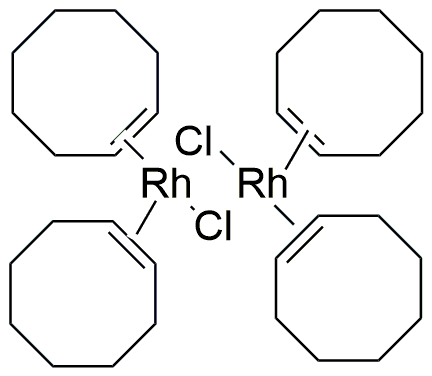Chlorobis(cyclooctene)rhodium(I) dimer is widely utilized in research focused on:
- Catalysis: This compound serves as an effective catalyst in various organic reactions, particularly in the formation of carbon-carbon bonds, which is essential in synthesizing complex molecules in pharmaceuticals.
- Polymerization Processes: It is employed in the polymer industry for the polymerization of cyclooctene, leading to the production of high-performance polymers with unique properties, suitable for specialized applications.
- Environmental Chemistry: Researchers use this compound in studies aimed at developing greener chemical processes, reducing waste, and improving the efficiency of chemical reactions.
- Material Science: The compound is explored in the development of novel materials, including advanced coatings and adhesives, due to its unique chemical properties that enhance material performance.
- Organometallic Chemistry: It plays a significant role in the field of organometallic chemistry, helping scientists understand metal-ligand interactions and their implications in catalysis and material synthesis.
General Information
Properties
Safety and Regulations
Applications
Chlorobis(cyclooctene)rhodium(I) dimer is widely utilized in research focused on:
- Catalysis: This compound serves as an effective catalyst in various organic reactions, particularly in the formation of carbon-carbon bonds, which is essential in synthesizing complex molecules in pharmaceuticals.
- Polymerization Processes: It is employed in the polymer industry for the polymerization of cyclooctene, leading to the production of high-performance polymers with unique properties, suitable for specialized applications.
- Environmental Chemistry: Researchers use this compound in studies aimed at developing greener chemical processes, reducing waste, and improving the efficiency of chemical reactions.
- Material Science: The compound is explored in the development of novel materials, including advanced coatings and adhesives, due to its unique chemical properties that enhance material performance.
- Organometallic Chemistry: It plays a significant role in the field of organometallic chemistry, helping scientists understand metal-ligand interactions and their implications in catalysis and material synthesis.
Documents
Safety Data Sheets (SDS)
The SDS provides comprehensive safety information on handling, storage, and disposal of the product.
Product Specification (PS)
The PS provides a comprehensive breakdown of the product’s properties, including chemical composition, physical state, purity, and storage requirements. It also details acceptable quality ranges and the product's intended applications.
Certificates of Analysis (COA)
Search for Certificates of Analysis (COA) by entering the products Lot Number. Lot and Batch Numbers can be found on a product’s label following the words ‘Lot’ or ‘Batch’.
*Catalog Number
*Lot Number
Certificates Of Origin (COO)
This COO confirms the country where the product was manufactured, and also details the materials and components used in it and whether it is derived from natural, synthetic, or other specific sources. This certificate may be required for customs, trade, and regulatory compliance.
*Catalog Number
*Lot Number
Safety Data Sheets (SDS)
The SDS provides comprehensive safety information on handling, storage, and disposal of the product.
DownloadProduct Specification (PS)
The PS provides a comprehensive breakdown of the product’s properties, including chemical composition, physical state, purity, and storage requirements. It also details acceptable quality ranges and the product's intended applications.
DownloadCertificates of Analysis (COA)
Search for Certificates of Analysis (COA) by entering the products Lot Number. Lot and Batch Numbers can be found on a product’s label following the words ‘Lot’ or ‘Batch’.
*Catalog Number
*Lot Number
Certificates Of Origin (COO)
This COO confirms the country where the product was manufactured, and also details the materials and components used in it and whether it is derived from natural, synthetic, or other specific sources. This certificate may be required for customs, trade, and regulatory compliance.


